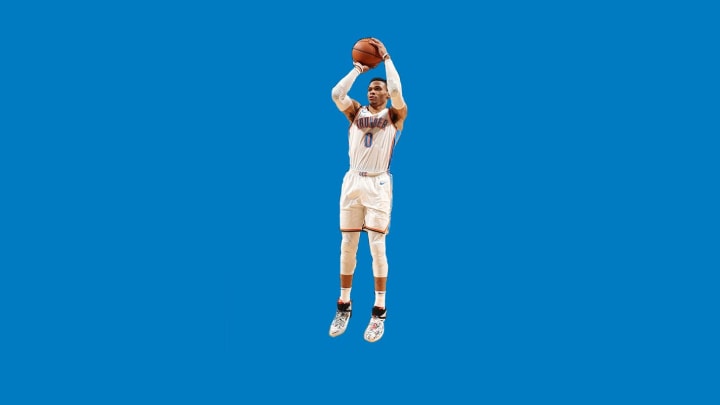Few things are scarier for a defender than Russell Westbrook coming full steam at the basket in transition. Westbrook has made his name on unbelievable athleticism and there’s nowhere it’s more evident than in transition, when his freight train mentality reaches its peak.
Occasionally, he’ll use the fear he strikes in opponents’ hearts to change direction—not right to left with a Euro step, but horizontal to vertical, stopping at the free-throw line for his famous pull-up jumper.
Even Westbrook can’t go to the rim every trip down the floor, though he’d certainly like to try. When defenders hang back too far, anticipating his liftoff for another thunderous dunk, he transfers all his energy into a vertical leap, with brakes and re-acceleration that would make a Ferrari blush.
Read More: Jrue Holiday is having a career year
It’s rare a guy’s signature move comes about as a counter to the thing at which he’s best, but Westbrook’s pull-up jumper is exactly that. He’s a terror at the rim, able to dunk over the tallest and strongest players in the league. He isn’t a particularly effective shooter in the aggregate, but that jumper is just as devastating in the right situations and rounds out Westbrook’s offensive attack in a way that makes him one of the best players in the league.
As the league moves away from the mid-range jumper, Westbrook’s ability from that area keeps defenses honest. The stats aren’t there—he’s a middling mid-range shooter and a relatively poor shooter off the dribble. It’s not about efficiency with this particular aspect of his game. It’s about the fear in defender’s eyes when they realize they’ve backed off too much.
Other guys with Westbrook’s athletic profile have adopted his move. Dennis Smith Jr. and Eric Bledsoe both have the explosive athleticism that makes Westbrook a terror in transition. All three of these guys get defenders on their heels before rising up to knock in a jumper, leaving their opposition grasping at air.
Westbrook, Smith and Bledsoe usually use these moves against mismatches—when the defense is cross-matched in transition and they have a slower defender on them. Those defenders are predisposed to back up further than necessary in an attempt to keep those guys away from the basket.
These three, among others in the league, exploit this space either by attacking it and getting a layup, trip to the free-throw line or knocking down this jumper. Mismatches are an important part of running in transition, whether the offense pulls the trigger on a shot or not; putting extreme pressure on the defense can create openings later in the possession as well.
Derrick Rose is perhaps the modern godfather of this stop-and-pop jumper in transition. In particular, Rose helped to usher in an era of uber-athletic point guards with his MVP performance in 2010-11, breaking the mold of the get-everyone-involved-and-only-take-over-when-necessary point guard which had dominated the league for decades.
Rose’s pull-up jumper was effective for the same reasons that Westbrook’s continues to be today: he was terrific finishing at the basket in transition, the trait that was always at the forefront of his defender’s mind, and possessed the explosiveness to go from 60 to 0 in a split second, then get back up to 60, accelerating toward the roof of the building and knocking in the jumper before the defender could even react to put a hand up.
The next wave of point guards/primary creators are guys who don’t need a pull-up jumper because, well, they can just jump over and around anybody in their way for a dunk or layup. There’s no use in stopping for a 15-foot jumper when you can jump from 15 feet and dunk it:
Giannis Antetokounmpo has no need for a stop-and-pop jumper at this point in his career. If his defender is backing off, Antetokounmpo takes the space and dunks it on his head. Ben Simmons is similar to Antetokounmpo in this way—of the 54 shots he’s taking as the lead ball handler in transition this year, only four of them have come outside the restricted area (he’s 1-for-4 on such shots and 32-for-50 on layups and dunks through January 2). The pull-up jumper in transition has its uses, but not for guys who might be aliens.
Westbrook’s pull-up jumper remains a key part of his arsenal and the arsenals of young, explosive guards in today’s NBA. It keeps defenses off balance and serves as a counter to their finishing around the basket. When they can hit it at a respectable rate, it even opens up the basket a bit more, putting defenders on their toes, leaning forward ever so slightly. The other end of this spectrum is a high-level shooter (Stephen Curry, Damian Lillard), whose presence with the ball at the 3-point line sends defenses scrambling, opening up hesitation dribbles and blow-bys to the basket routinely.
Next: The Encyclopedia of Modern Moves
Just like Curry and Lillard carve out layups from their shooting ability, guys like Westbrook, Smith and Bledsoe get jumpers from their athleticism and finishing ability around the rim.
